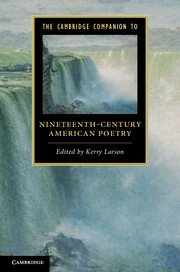Book contents
- Frontmatter
- Introduction
- I MANDATES, MOVEMENTS, AND MANIFESTOES
- II INDIVIDUAL AUTHORS
- 8 Longfellow’s ambivalence
- 9 Sarah Piatt’s grammar of convention and the conditions of authorship
- 10 Poe and Southern poetry
- 11 The color line: James Monroe Whitfield and Albery Allson Whitman
- 12 Colonial violence and poetic transcendence in Whitman’s “Song of Myself”
- 13 Emily Dickinson’s “turbaned seas”
- Selected guide to further reading
- Index
- Cambridge Companions to…
10 - Poe and Southern poetry
from II - INDIVIDUAL AUTHORS
Published online by Cambridge University Press: 28 November 2011
- Frontmatter
- Introduction
- I MANDATES, MOVEMENTS, AND MANIFESTOES
- II INDIVIDUAL AUTHORS
- 8 Longfellow’s ambivalence
- 9 Sarah Piatt’s grammar of convention and the conditions of authorship
- 10 Poe and Southern poetry
- 11 The color line: James Monroe Whitfield and Albery Allson Whitman
- 12 Colonial violence and poetic transcendence in Whitman’s “Song of Myself”
- 13 Emily Dickinson’s “turbaned seas”
- Selected guide to further reading
- Index
- Cambridge Companions to…
Summary
Their respective ties to the Southern United States alone might lead us to assign Edgar Allan Poe, Henry Timrod, and Sidney Lanier to a single Southern tradition. As we shall see, however, these writers were connected by a deeper tie that is evident in their engagement with each other's work on the topic of poetics. The mutual engagement among these authors yields a conceptual tradition, but one in which, as we shall see, different emphases arise: Poe reveals a transcendental concern with romantic aesthetics, Timrod reveals a nationalist concern with Southern Confederate autonomy, and Lanier reveals a racial concern with Anglo-Saxon ethnic difference. In what follows I will treat each of these writers in turn, moving chronologically through Poe and Timrod to Lanier in order to sketch the differing views that emerge from these authors' engagement with each other.
Edgar Allan Poe was born in 1809 in Boston and was educated at the University of Virginia and West Point. His education was primarily in ancient and modern languages, which gave him access to poetic works indirectly, but he did not make the study of poetry itself a central academic pursuit. Instead, his poetic collections appeared in a manner that was ancillary to his academic work. These collections included a first in 1827, a second in 1829, a third in 1831, and a fourth in 1845, with several uncollected poems rounding out his total output. Poe's poetic writings form just a fraction of his total written work, much of which consists of prose short stories.
- Type
- Chapter
- Information
- The Cambridge Companion to Nineteenth-Century American Poetry , pp. 193 - 207Publisher: Cambridge University PressPrint publication year: 2011

